Diatomite-Metal-Organic Framework Composite with Hierarchical Pore Structures for Adsorption/Desorption of Hydrogen, Carbon Dioxide and Water Vapor
Abstract
1. Introduction
2. Materials and Methods
2.1. Materials
2.2. Synthesis of Cr-MIL-101 and Cr-MIL-101@Da
2.3. Bulk Properties
2.4. Chemical Analyses
2.5. Gas Adsorption
2.6. Isosteric Heat of Adsorption for CO2
3. Results
3.1. Cr-MIL-101
3.2. Cr-MIL-101@Da Composites
3.3. Chemistry
3.4. Porosity and Specific Surface Area
3.5. Gas Adsorption–Desorption
3.5.1. Hydrogen Isotherms
3.5.2. Carbon Dioxide Isotherms
3.5.3. Water Vapor Isotherms
3.6. Thermal and Hydrolytic Stability
4. Discussion
4.1. Cr-MIL-101@Da Composites
4.2. H2 and CO2 Adsorptive Performance
4.3. H2O Adsorptive Performance
4.4. Thermal and Hydrolytic Stability
5. Conclusions
Supplementary Materials
Author Contributions
Funding
Acknowledgments
Conflicts of Interest
References
- Cui, Y.; Li, B.; He, H.; Zhou, W.; Chen, B.; Qian, G. Metal–organic frameworks as platforms for functional materials. Acc. Chem. Res. 2016, 49, 483–493. [Google Scholar] [CrossRef]
- Li, B.; Wen, H.-M.; Cui, Y.; Zhou, W.; Qian, G.; Chen, B. Emerging multifunctional metal-organic framework materials. Adv. Mater. 2016, 28, 8819–8860. [Google Scholar] [CrossRef]
- Wang, H.; Zhu, Q.-L.; Zou, R.; Xu, Q. Metal-organic frameworks for energy applications. Chem 2017, 2, 52–80. [Google Scholar] [CrossRef]
- Illes, B.; Hirschle, P.; Barnert, S.; Cauda, V.A.; Wuttke, S.; Engelke, H. Exosome-coated metal–organic framework nanoparticles: An efficient drug delivery platform. Chem. Mater. 2017, 29, 8042–8046. [Google Scholar] [CrossRef]
- Wang, Q.; Astruc, D. State of the art and prospects in metal–organic framework (MOF)-based and MOF-derived nanocatalysis. Chem. Rev. 2019, 120, 1438–1511. [Google Scholar] [CrossRef] [PubMed]
- Kalmutzki, M.J.; Diercks, C.S.; Yaghi, O.M. Metal-organic frameworks for water harvesting from air. Adv. Mater. 2018, 30, e1704304. [Google Scholar] [CrossRef] [PubMed]
- Rieth, A.J.; Wright, A.M.; Dincă, M. Kinetic stability of metal–organic frameworks for corrosive and coordinating gas capture. Nat. Rev. Mater. 2019, 4, 708–725. [Google Scholar] [CrossRef]
- Bobbitt, N.S.; Chen, J.; Snurr, R.Q. High-throughput screening of metal–organic frameworks for hydrogen storage at cryogenic temperature. J. Phys. Chem. C 2016, 120, 27328–27341. [Google Scholar] [CrossRef]
- Cho, H.S.; Deng, H.; Miyasaka, K.; Dong, Z.; Cho, M.; Neimark, A.V.; Kang, J.K.; Yaghi, O.M.; Terasaki, O. Extra adsorption and adsorbate superlattice formation in metal-organic frameworks. Nat. Cell Biol. 2015, 527, 503–507. [Google Scholar] [CrossRef]
- Bloch, E.D.; Queen, W.L.; Hudson, M.R.; Mason, J.A.; Xiao, D.J.; Murray, L.J.; Flacau, R.; Brown, C.M.; Long, J.R. Hydrogen storage and selective, reversible O2 adsorption in a metal-organic framework with open chromium (II) sites. Angew. Chem. Int. Ed. 2016, 55, 8605–8609. [Google Scholar] [CrossRef]
- Moreau, F.; Da Silva, I.; Al Smail, N.H.; Easun, T.L.; Savage, M.; Godfrey, H.G.W.; Parker, S.F.; Manuel, P.; Yang, S.; Schröder, M. Unravelling exceptional acetylene and carbon dioxide adsorption within a tetra-amide functionalized metal-organic framework. Nat. Commun. 2017, 8, 14085. [Google Scholar] [CrossRef] [PubMed]
- Gangu, K.K.; Maddila, S.; Mukkamala, S.B.; Jonnalagadda, S.B. Characteristics of MOF, MWCNT and graphene containing materials for hydrogen storage: A review. J. Energy Chem. 2019, 30, 132–144. [Google Scholar] [CrossRef]
- Song, X.; Zhang, M.; Chen, C.; Duan, J.; Zhang, W.; Pan, Y.; Bai, J. Pure-supramolecular-linker approach to highly connected metal–organic frameworks for CO2 capture. J. Am. Chem. Soc. 2019, 141, 14539–14543. [Google Scholar] [CrossRef] [PubMed]
- Ullah, S.; Bustam, M.A.; Assiri, M.A.; Al-Sehemi, A.G.; Sagir, M.; Kareem, F.A.A.; Elkhalifah, A.E.; Mukhtar, A.; Gonfa, G. Synthesis, and characterization of metal-organic frameworks -177 for static and dynamic adsorption behavior of CO2 and CH4. Microporous Mesoporous Mater. 2019, 288, 109569. [Google Scholar] [CrossRef]
- Ma, L.; Falkowski, J.M.; Abney, C.; Lin, W. A series of isoreticular chiral metal–organic frameworks as a tunable platform for asymmetric catalysis. Nat. Chem. 2010, 2, 838–846. [Google Scholar] [CrossRef]
- Rieth, A.J.; Wright, A.M.; Rao, S.; Kim, H.; LaPotin, A.D.; Wang, E.N.; Dincă, M. Tunable metal-organic frameworks enable high-efficiency cascaded adsorption heat pumps. J. Am. Chem. Soc. 2018, 140, 17591–17596. [Google Scholar] [CrossRef]
- Yang, P.; Zhao, W.; Shkurenko, A.; Belmabkhout, Y.; Eddaoudi, M.; Dong, X.; Alshareef, H.N.; Khashab, N.M. Polyoxometalate–cyclodextrin metal-organic frameworks: From tunable structure to customized storage functionality. J. Am. Chem. Soc. 2019, 141, 1847–1851. [Google Scholar] [CrossRef]
- Ma, Q.; Yin, P.; Zhao, M.; Luo, Z.; Huang, Y.; He, Q.; Yu, Y.; Liu, Z.; Hu, Z.; Chen, B.; et al. MOF-based hierarchical structures for solar-thermal clean water production. Adv. Mater. 2019, 31, e1808249. [Google Scholar] [CrossRef]
- Zheng, J.; Vemuri, R.S.; Estevez, L.; Koech, P.K.; Varga, T.; Camaioni, D.M.; Blake, T.A.; McGrail, B.P.; Motkuri, R.K. Pore-engineered metal-organic frameworks with excellent adsorption of water and fluorocarbon refrigerant for cooling applications. J. Am. Chem. Soc. 2017, 139, 10601–10604. [Google Scholar] [CrossRef]
- Kleist, W.; Maciejewski, M.; Baiker, A. MOF-5 based mixed-linker metal–organic frameworks: Synthesis, thermal stability and catalytic application. Thermochim. Acta. 2010, 499, 71–78. [Google Scholar] [CrossRef]
- Liu, G.; Cadiau, A.; Liu, Y.; Adil, K.; Chernikova, V.; Carja, I.-D.; Belmabkhout, Y.; Karunakaran, M.; Shekhah, O.; Zhang, C.; et al. Enabling fluorinated MOF-based membranes for simultaneous removal of H2 S and CO2 from natural gas. Angew. Chem. Int. Ed. 2018, 57, 14811–14816. [Google Scholar] [CrossRef] [PubMed]
- Ferey, G.; Mellot-Draznieks, C.; Serre, C.; Millange, F.; Dutour, J.; Surblé, S.; Margiolaki, I. A Chromium terephthalate-based solid with unusually large pore volumes and surface area. Science 2005, 309, 2040–2042. [Google Scholar] [CrossRef] [PubMed]
- Lebedev, O.I.; Millange, F.; Serre, C.; Van Tendeloo, A.G.; Férey, G. First direct imaging of giant pores of the metal−organic framework MIL-101. Chem. Mater. 2005, 17, 6525–6527. [Google Scholar] [CrossRef]
- Hong, D.-Y.; Hwang, Y.K.; Serre, C.; Férey, G.; Chang, J.-S. Porous chromium terephthalate MIL-101 with coordinatively unsaturated sites: Surface functionalization, encapsulation, sorption and catalysis. Adv. Funct. Mater. 2009, 19, 1537–1552. [Google Scholar] [CrossRef]
- Yuan, S.; Feng, L.; Wang, K.; Pang, J.; Bosch, M.; Lollar, C.; Sun, Y.; Qin, J.; Yang, X.; Zhang, P.; et al. Stable metal-organic frameworks: Design, synthesis, and applications. Adv. Mater. 2018, 30, e1704303. [Google Scholar] [CrossRef] [PubMed]
- Zhu, B.; Zou, R.; Xu, Q. Metal-organic framework based catalysts for hydrogen evolution. Adv. Energy Mater. 2018, 8, 1801193. [Google Scholar] [CrossRef]
- Burtch, N.C.; Jasuja, H.; Walton, K.S. Water Stability and Adsorption in Metal–Organic Frameworks. Chem. Rev. 2014, 114, 10575–10612. [Google Scholar] [CrossRef] [PubMed]
- Khan, N.A.; Kang, I.J.; Seok, H.Y.; Jhung, S.H. Facile synthesis of nano-sized metal-organic frameworks, chromium-benzenedicarboxylate, MIL-101. Chem. Eng. J. 2011, 166, 1152–1157. [Google Scholar] [CrossRef]
- He, S.; Wang, H.; Zhang, C.; Zhang, S.; Yu, Y.; Lee, Y.; Li, T. A generalizable method for the construction of MOF @ polymer functional composites through surface-initiated atom transfer radical polymerization. Chem. Sci. 2019, 10, 1816–1822. [Google Scholar] [CrossRef]
- Rodenas, T.; Luz, I.; Prieto, G.; Seoane, B.; Miro, H.; Corma, A.; Kapteijn, F.; Xamena, F.X.L.I.; Gascon, J. Metal-organic framework nanosheets in polymer composite materials for gas separation. Nat. Mater. 2014, 14, 48–55. [Google Scholar] [CrossRef]
- Sun, M.; Chen, W.-C.; Zhao, L.; Wang, X.; Su, Z.-M. A PTA @ MIL-101 (Cr)-diatomite composite as catalyst for efficient oxidative desulfurization. Inorg. Chem. Commun. 2018, 87, 30–35. [Google Scholar] [CrossRef]
- Liu, D.; Gu, J.; Liu, Q.; Tan, Y.; Li, Z.; Zhang, W.; Su, Y.; Li, W.; Cui, A.; Gu, C.; et al. Metal-organic frameworks reactivate deceased diatoms to be efficient CO2 absorbents. Adv. Mater. 2013, 26, 1229–1234. [Google Scholar] [CrossRef] [PubMed]
- Dantas, S.; Sarkisov, L.; Neimark, A.V. Deciphering the relations between pore structure and adsorption behavior in metal-organic frameworks: Unexpected lessons from argon adsorption on copper-benzene-1,3,5-tricarboxylate. J. Am. Chem. Soc. 2019, 141, 8397–8401. [Google Scholar] [CrossRef]
- Lu, J.; Wu, J.-K.; Jiang, Y.; Tan, P.; Zhang, L.; Lei, Y.; Liu, X.-Q.; Sun, L.-B. Fabrication of microporous metal-organic frameworks in uninterrupted mesoporous tunnels: Hierarchical structure for efficient trypsin immobilization and stabilization. Angew. Chem. Int. Ed. 2020, 59, 6428–6434. [Google Scholar] [CrossRef] [PubMed]
- Zhao, T.; Yang, L.; Feng, P.; Gruber, I.; Janiak, C.; Liu, Y. Facile synthesis of nano-sized MIL-101(Cr) with the addition of acetic acid. Inorg. Chim. Acta 2018, 471, 440–445. [Google Scholar] [CrossRef]
- Guo, Q.; Ren, L.; Kumar, P.; Cybulskis, V.J.; Mkhoyan, K.A.; Davis, M.E.; Tsapatsis, M. A chromium hydroxide/MIL-101(Cr) MOF composite catalyst and its use for the selective isomerization of glucose to fructose. Angew. Chem. Int. Ed. 2018, 57, 4926–4930. [Google Scholar] [CrossRef] [PubMed]
- Rosi, N.L.; Eckert, J.; Eddaoudi, M.; Vodak, D.T.; Kim, J.; O’Keeffe, M.; Yaghi, O.M. Hydrogen storage in microporous metal-organic frameworks. Science 2003, 300, 1127–1129. [Google Scholar] [CrossRef]
- Yang, S.J.; Jung, H.; Kim, T.; Im, J.H.; Park, C.R. Effects of structural modifications on the hydrogen storage capacity of MOF-5. Int. J. Hydrogen Energy 2012, 37, 5777–5783. [Google Scholar] [CrossRef]
- Murray, L.J.; Dincă, M.; Long, J.R. Hydrogen storage in metal-organic frameworks. Chem. Soc. Rev. 2009, 38, 1294–1314. [Google Scholar] [CrossRef]
- Mason, J.A.; Sumida, K.; Herm, Z.R.; Krishna, R.; Long, J.R. Evaluating metal-organic frameworks for post-combustion carbon dioxide capture via temperature swing adsorption. Energy Environ. Sci. 2011, 4, 3030–3040. [Google Scholar] [CrossRef]
- Li, H.; Wang, K.; Feng, D.; Chen, Y.-P.; Verdegaal, W.; Zhou, H. Incorporation of alkylamine into metal-organic frameworks through a Brønsted acid-base reaction for CO2 capture. ChemSusChem 2016, 9, 2832–2840. [Google Scholar] [CrossRef] [PubMed]
- Bhatt, P.M.; Belmabkhout, Y.; Cadiau, A.; Adil, K.; Shekhah, O.; Shkurenko, A.; Barbour, L.J.; Eddaoudi, M. A fine-tuned fluorinated MOF addresses the needs for trace CO2 removal and air capture using physisorption. J. Am. Chem. Soc. 2016, 138, 9301–9307. [Google Scholar] [CrossRef] [PubMed]
- Abtab, S.M.T.; Alezi, D.; Bhatt, P.M.; Shkurenko, A.; Belmabkhout, Y.; Aggarwal, H.; Weseliński, L.J.; Alsadun, N.; Samin, U.; Hedhili, M.N.; et al. Reticular chemistry in action: A hydrolytically stable MOF capturing twice its weight in adsorbed water. Chem 2018, 4, 94–105. [Google Scholar] [CrossRef]
- Horcajada, P.; Chalati, T.; Serre, C.; Gillet, B.; Sebrie, C.; Baati, T.; Eubank, J.F.; Heurtaux, D.; Clayette, P.; Kreuz, C.; et al. Porous metal-organic-framework nanoscale carriers as a potential platform for drug delivery and imaging. Nat. Mater. 2009, 9, 172–178. [Google Scholar] [CrossRef]
- Jiang, D.; Burrows, A.D.; Edler, K.J. Size-controlled synthesis of MIL-101(Cr) nanoparticles with enhanced selectivity for CO2 over N2. CrystEngComm 2011, 13, 6916–6919. [Google Scholar] [CrossRef]
- Carné-Sánchez, A.; Carbonell, C.; Imaz, I.; Maspoch, D. Nanoscale metal-organic materials. Chem. Soc. Rev. 2011, 40, 291–305. [Google Scholar] [CrossRef]
- Ding, M.; Cai, X.; Jiang, H.-L. Improving MOF stability: Approaches and applications. Chem. Sci. 2019, 10, 10209–10230. [Google Scholar] [CrossRef]
- Shen, J.; Wang, N.; Wang, Y.-G.; Yu, D.; Ouyang, X.-K. Efficient adsorption of Pb (II) from aqueous solutions by metal organic framework (Zn-BDC) coated magnetic montmorillonite. Polymers 2018, 10, 1383. [Google Scholar] [CrossRef]
- Xie, X.-Y.; Qian, X.; Qi, S.-C.; Wu, J.-K.; Liu, X.-Q.; Sun, L.-B. Endowing Cu-BTC with improved hydrothermal stability and catalytic activity: Hybridization with natural clay attapulgite via vapor-induced crystallization. ACS Sustain. Chem. Eng. 2018, 6, 13217–13225. [Google Scholar] [CrossRef]
- Wang, Z.; Ge, L.; Li, M.; Lin, R.; Wang, H.; Zhu, Z. Orientated growth of copper-based MOF for acetylene storage. Chem. Eng. J. 2019, 357, 320–327. [Google Scholar] [CrossRef]
- Ma, L.; Rathnayake, S.I.; He, H.; Zhu, R.; Zhu, R.; Ayoko, G.A.; Li, J.; Xi, Y. In situ sequentially generation of acid and ferrous ions for environmental remediation. Chem. Eng. J. 2016, 302, 223–232. [Google Scholar] [CrossRef]
- Li, H.; Wang, K.; Sun, Y.; Lollar, C.T.; Li, J.; Zhou, H.-C. Recent advances in gas storage and separation using metal-organic frameworks. Mater. Today 2018, 21, 108–121. [Google Scholar] [CrossRef]
- Kim, H.; Yang, S.; Rao, S.R.; Narayanan, S.; Kapustin, E.A.; Furukawa, H.; Umans, A.S.; Yaghi, O.M.; Wang, E.N. Water harvesting from air with metal-organic frameworks powered by natural sunlight. Science 2017, 356, 430–434. [Google Scholar] [CrossRef] [PubMed]
- Lenzen, D.; Zhao, J.; Ernst, S.-J.; Wahiduzzaman, M.; Inge, A.K.; Fröhlich, D.; Xu, H.; Bart, H.-J.; Janiak, C.; Henninger, S.K.; et al. A metal-organic framework for efficient water-based ultra-low-temperature-driven cooling. Nat. Commun. 2019, 10, 3025. [Google Scholar] [CrossRef] [PubMed]
- Rieth, A.J.; Wright, A.M.; Skorupskii, G.; Mancuso, J.L.; Hendon, C.H.; Dincă, M. Record-setting sorbents for reversible water uptake by systematic anion exchanges in metal-organic frameworks. J. Am. Chem. Soc. 2019, 141, 13858–13866. [Google Scholar] [CrossRef]


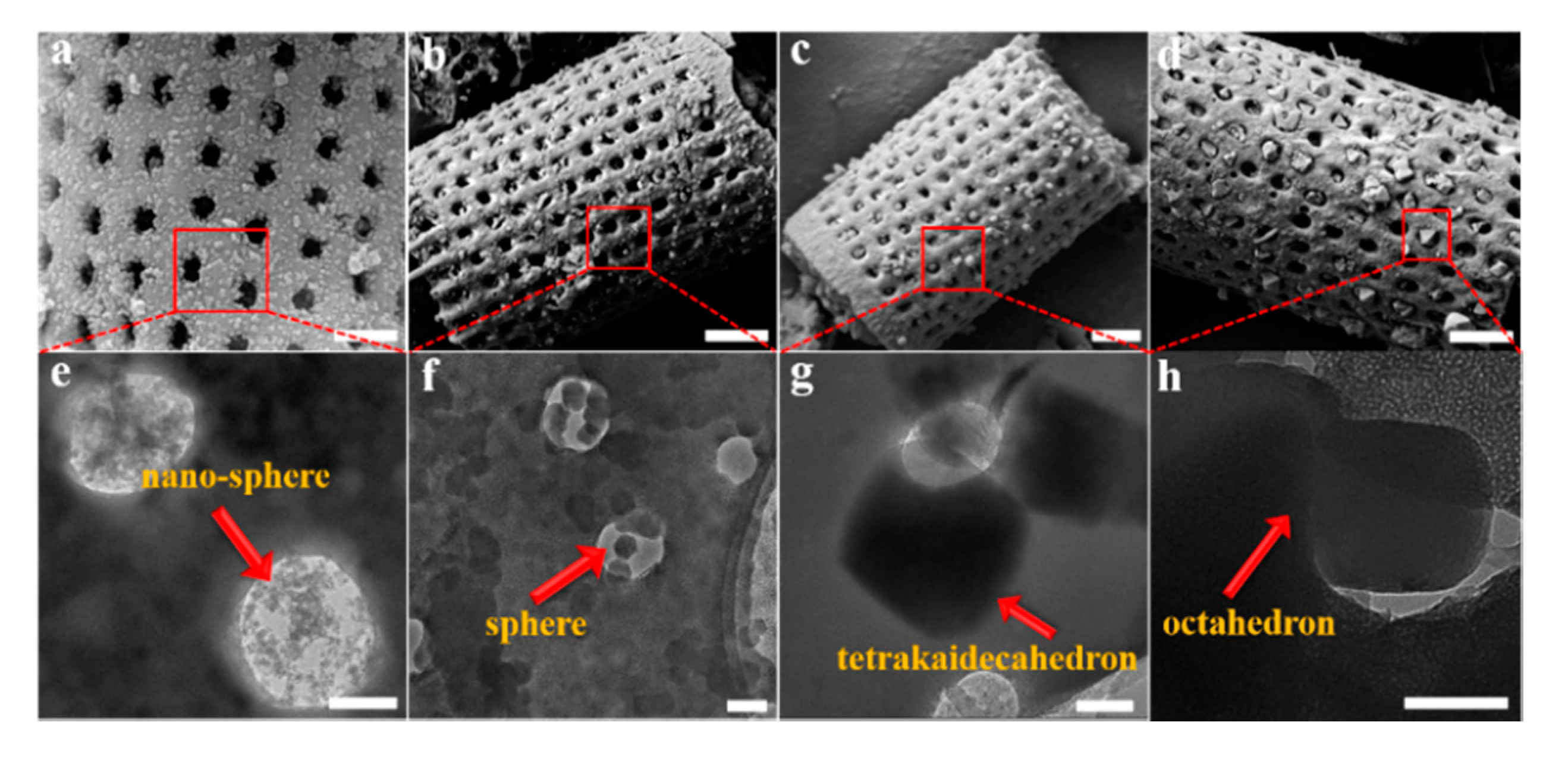
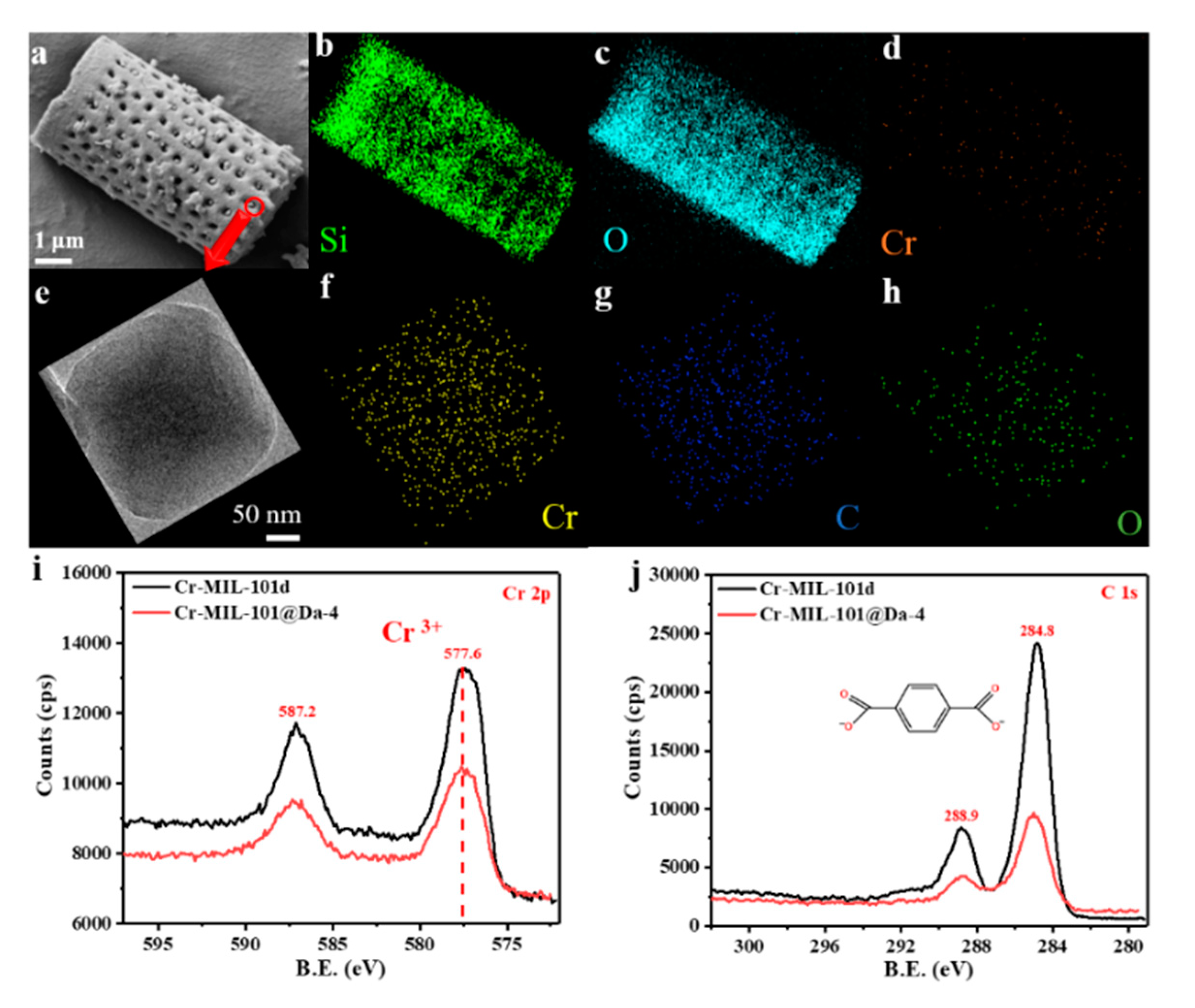

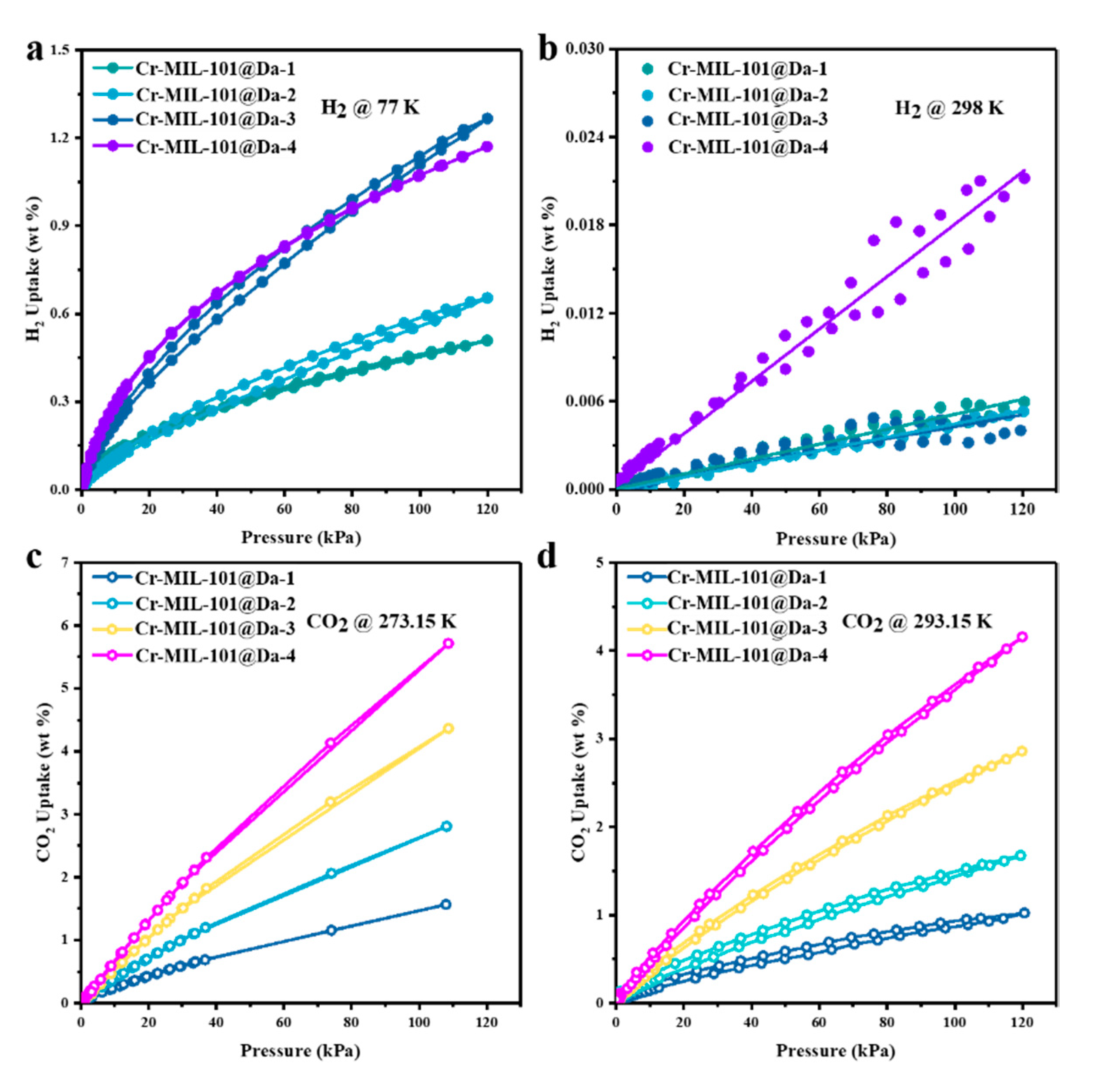
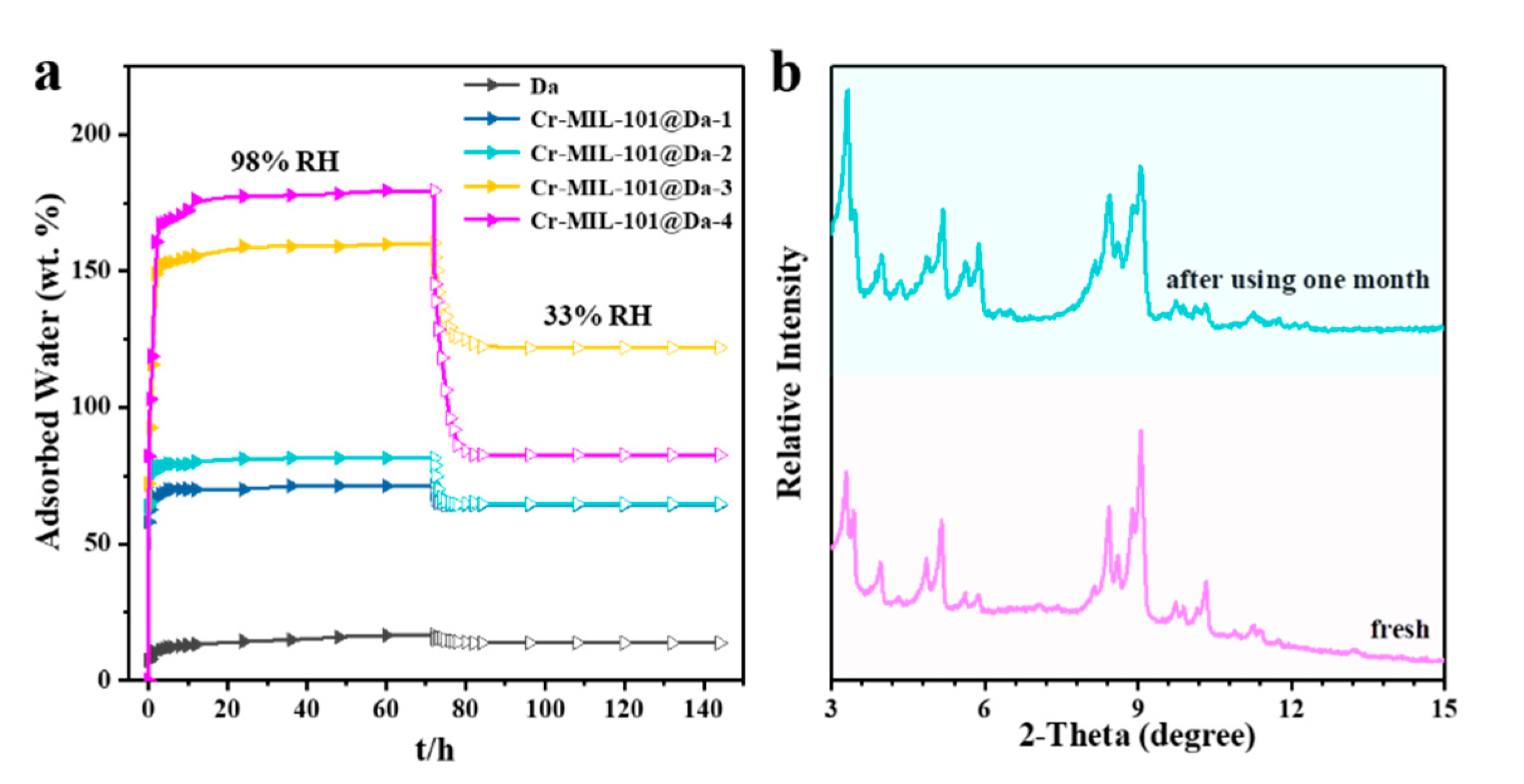
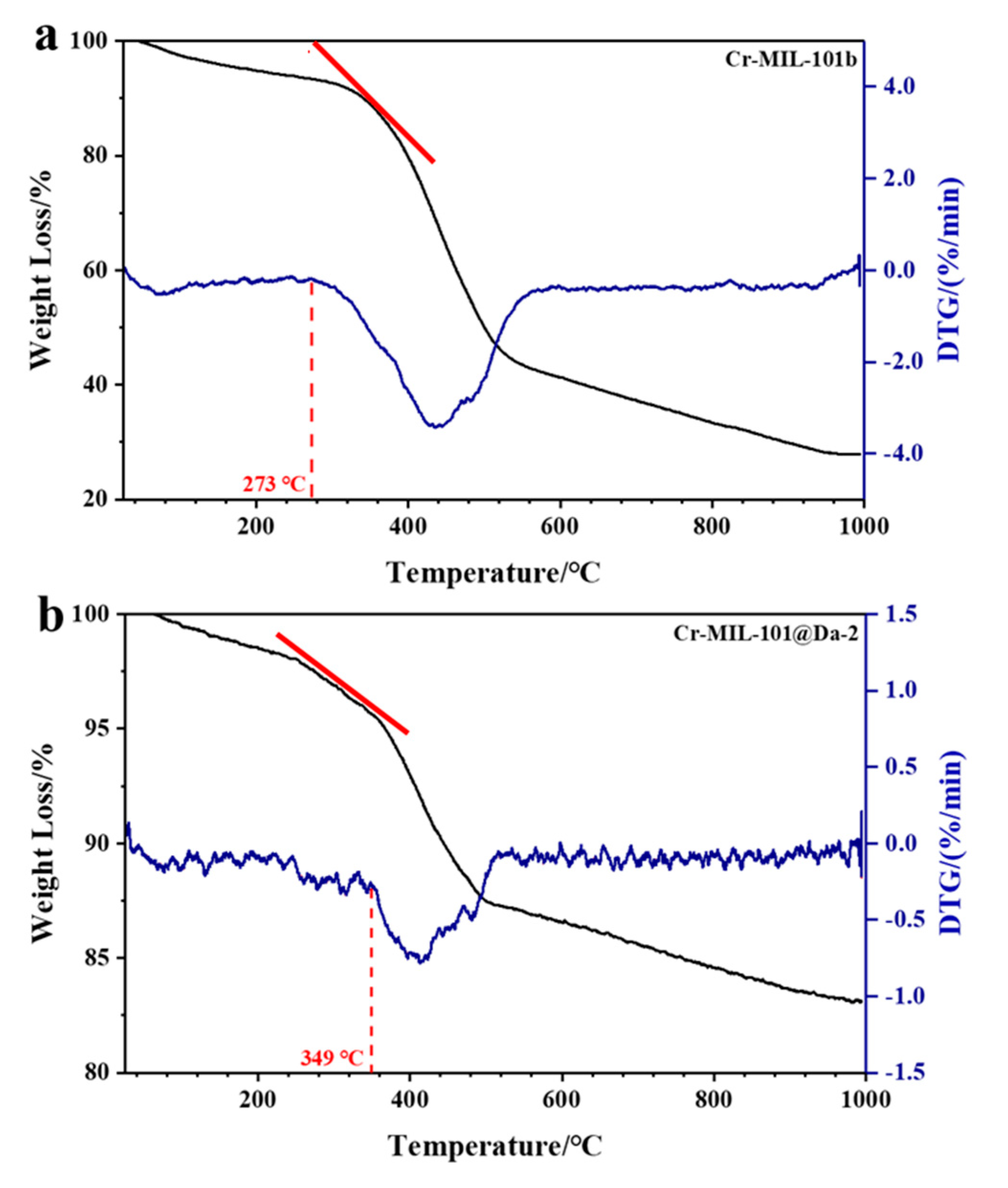
| Samples | Yield (%) | Samples | Yield (%) | Increased Yield (%) |
|---|---|---|---|---|
| Cr-MIL-101a | 49 | Cr-MIL-101@Da-1 | 92 | 43 |
| Cr-MIL-101b | 36 | Cr-MIL-101@Da-2 | 79 | 43 |
| Cr-MIL-101c | 36 | Cr-MIL-101@Da-3 | 75 | 39 |
| Cr-MIL-101d | 39 | Cr-MIL-101@Da-4 | 72 | 33 |
| BET Surface Area (m2/g) | Mesoporous Pore Diameter a | Microporous Pore Diameter b | Total Pore Volume (cm3/g) c | |||||
|---|---|---|---|---|---|---|---|---|
| N2 | Ar | N2 | Ar | N2 | Ar | N2 | Ar | |
| Cr-MIL-101a | 1395 | 2621 | 6.9 | 5.6 | 0.68 | 0.81 | 0.95 | 1.65 |
| Cr-MIL-101@Da-1 | 218 | 262 | 6.1 | 3 | 0.72 | 0.81 | 0.18 | 0.17 |
| Cr-MIL-101b | 1535 | 2406 | 5.3 | 3.5 | 0.69 | 0.75 | 0.69 | 1.01 |
| Cr-MIL-101@Da-2 | 415 | 458 | 4 | 2.7 | 0.75 | 0.8 | 0.16 | 0.21 |
| Cr-MIL-101c | 1797 | 2552 | 2.6 | 2.3 | 0.72 | 0.79 | 0.44 | 0.67 |
| Cr-MIL-101@Da-3 | 482 | 680 | 3 | 2.9 | 0.71 | 0.75 | 0.12 | 0.25 |
| Cr-MIL-101d | 2391 | 2191 | 2.3 | 2.3 | 0.71 | 0.75 | 0.53 | 0.5 |
| Cr-MIL-101@Da-4 | 1241 | 1146 | 2.9 | 2.6 | 0.75 | 0.79 | 0.3 | 0.37 |
| Da | 37 | NA | 8.5 | NA | 0.73 | NA | 0.05 | NA |
| Sample | MOF | MOF@Da | ΔTd (°C) | Ref |
|---|---|---|---|---|
| Td (°C) | Td (°C) | |||
| Cr-MIL-101a | 330 | 341 | 11 | This work |
| Cr-MIL-101b | 273 | 349 | 76 | This work |
| Cr-MIL-101c | 281 | 341 | 60 | This work |
| Cr-MIL-101d | 276 | 276, 305 | 0, 29 | This work |
| MIL-101 | 275 | - | - | [24] |
Publisher’s Note: MDPI stays neutral with regard to jurisdictional claims in published maps and institutional affiliations. |
© 2020 by the authors. Licensee MDPI, Basel, Switzerland. This article is an open access article distributed under the terms and conditions of the Creative Commons Attribution (CC BY) license (http://creativecommons.org/licenses/by/4.0/).
Share and Cite
Wang, G.; Graham, E.; Zheng, S.; Zhu, J.; Zhu, R.; He, H.; Sun, Z.; Mackinnon, I.D.R.; Xi, Y. Diatomite-Metal-Organic Framework Composite with Hierarchical Pore Structures for Adsorption/Desorption of Hydrogen, Carbon Dioxide and Water Vapor. Materials 2020, 13, 4700. https://doi.org/10.3390/ma13214700
Wang G, Graham E, Zheng S, Zhu J, Zhu R, He H, Sun Z, Mackinnon IDR, Xi Y. Diatomite-Metal-Organic Framework Composite with Hierarchical Pore Structures for Adsorption/Desorption of Hydrogen, Carbon Dioxide and Water Vapor. Materials. 2020; 13(21):4700. https://doi.org/10.3390/ma13214700
Chicago/Turabian StyleWang, Gaofeng, Elizabeth Graham, Shuilin Zheng, Jianxi Zhu, Runliang Zhu, Hongping He, Zhiming Sun, Ian D. R. Mackinnon, and Yunfei Xi. 2020. "Diatomite-Metal-Organic Framework Composite with Hierarchical Pore Structures for Adsorption/Desorption of Hydrogen, Carbon Dioxide and Water Vapor" Materials 13, no. 21: 4700. https://doi.org/10.3390/ma13214700
APA StyleWang, G., Graham, E., Zheng, S., Zhu, J., Zhu, R., He, H., Sun, Z., Mackinnon, I. D. R., & Xi, Y. (2020). Diatomite-Metal-Organic Framework Composite with Hierarchical Pore Structures for Adsorption/Desorption of Hydrogen, Carbon Dioxide and Water Vapor. Materials, 13(21), 4700. https://doi.org/10.3390/ma13214700











